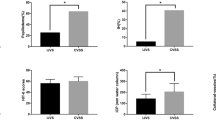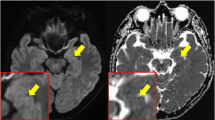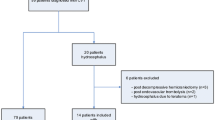Abstract
Objective
While transient global amnesia (TGA) is a clinically well defined disorder, its etiology is poorly understood. Cerebral venous hypertension and subsequent damage to hippocampal and diencephalic structures are among the discussed hypothetical causes. Using a direct method for the study of retrograde flow during a Valsalva maneuver, we determined whether jugular valve insufficiency contributes to cerebral venous hypertension in patients with TGA.
Methods
Jugular valve closure was assessed by duplex sonography in 20 patients with TGA and 20 age and gender matched controls. The diagnosis of valvular insufficiency was made on the basis of recently established criteria.
Results
Valvular insufficiency (either left or rightsided, or bilateral) was identified in 85% of patients with TGA,and in 45% of controls (p = 0.008). All patients with involuntary Valsalva episodes immediately prior to TGA developed valvular insufficiency (n = 8; p = 0.13 compared with patients who did not recall such an event). The mean duration of the insufficiency jet did not differ significantly between patients with TGA (3.26s) and controls (2.78s; p = 0.315). However, patients with TGA who experienced a trigger event were characterized by significantly longer insufficiency reflux times (3.84s) than those without (2.55s; p = 0.03).
Conclusions
TGA is associated with an increase in the prevalence of jugular insufficiency. Valvular insufficiency may lead to increased venous pressure transmission during a Valsalva maneuver and thus contribute to venous ischemia in TGA. The association of valvular insufficiency and longer reflux times with the occurrence of a trigger event further suggests that cerebral venous congestion is an important etiological factor in transient global amnesia.
Similar content being viewed by others
References
Akkawi NM, Agosti C, Rozzini L, Anzola GP, Padovani A (2001) Transient global amnesia and venous flow patterns. Lancet 357:639
Akkawi NM, Agosti C, Anzola GP, Borroni B, Magoni M, Pezzini A, Rozzini L, Vignolo LA, Padovani A (2003) Transient global amnesia: a clinical and sonographic study. Eur Neurol 49:67–71
Ay H, Furie KL, Yamada K, Koroshetz WJ (1998) Diffusion–weighted MRI characterizes the ischemic lesion in transient global amnesia. Neurology 51:901–903
Borroni B, Agosti C, Brambilla C, Vergani V, Cottini E, Akkawi N, Padovani A (2004) Is transient global amnesia a risk factor for amnesic mild cognitive impairment? J Neurol 251:1125–1127
Gorji A (2001) Spreading depression: a review of the clinical relevance. Brain Res Rev 38:33–60
Harmon JV, Edwards WD (1986) Venous valves in subclavian and internal jugular veins. Frequency, position and structure in 100 autopsy cases. Am J Cardiovasc Pathol 1:51–54
Hodges JR, Warlow CP (1990) The aetiology of transient global amnesia. A case–control study of 114 cases with prospective follow–up. Brain 113:639–657
Kastrup A, Neumann–Haefelin T, Moseley ME, de Crespigny A (2000) High speed diffusion magnetic resonance imaging of ischemia and spontaneous periinfarct spreading depression after thromboembolic stroke in the rat. J Cereb Blood Flow Metab 20:1636–1647
Kessler J, Markowitsch HJ, Rudolf J, Heiss WD (2001) Continuing cognitive impairment after isolated transient global amnesia. Int J Neurosci 106:159–168
Lewis SL (1998) Aetiology of transient global amnesia. Lancet 352:397–399
Nedelmann M, Eicke BM, Dieterich M (2005) Functional and morphological criteria of internal jugular valve insufficiency as assessed by ultrasound. J Neuroimaging 15:70–75
Olesen J, Joergensen MB (1986) Leao’s spreading depression in the hippocampus explains transient global amnesia. Acta Neurol Scand 73:219–220
Ratanakorn D, Tegeler CH, Tesh PE (1999) A new dynamic method for detection of internal jugular valve incompetence using air contrast ultrasonography. J Neuroimaging 9:10–14
Rodriguez AA, Whitehead CM, McLaughlin RL, Umphrey SE, Welch HJ, O’Donnell TF (1996) Duplex–derived valve closure times fail to correlate with reflux flow volumes in patients with chronic venous insufficiency. J Vasc Surg 23:606–610
Roether J, De Crespigny AJ, D’Arceuil H, Moseley ME (1996) MR detection of cortical spreading depression immediately after focal ischemia in the rat. J Cereb Blood Flow Metab 16:214–220
Sander D, Winbek K, Etgen T, Knapp R, Klingelhöfer J, Conrad B (2000) Disturbance of venous flow patterns in patients with transient global amnesia. Lancet 356:1982–1984
Sedlaczek O, Hirsch JG, Grips E, Peters CN, Gass A, Wohrle J, Hennerici M (2004) Detection of delayed focal MR changes in the lateral hippocampus in transient global amnesia. Neurology 62:2165–2170
Strupp M, Bruening R, Hua Wu R, Deimling M, Reiser M, Brandt T (1998) Diffusion–weighted MRI in transient global amnesia: elevated signal intensity in the left mesial temporal lobe in 7 of 10 patients. Ann Neurol 43:164–170
Tong DC, Grossman M (2004) What causes transient global amnesia? New insights from DWI. Neurology 62:2154–2155
Weingarten MS, Czeredarczuk M, Scovell S, Branas CC, Mignogna GM, Wolferth CC (1996) A correlation of air plethysmography and color–flow–assisted duplex scanning in the quantification of chronic venous insufficiency. J Vasc Surg 24:750–754
Wu X, Studer W, Erb T, Skarvan K, Seeberger MD (2000) Competence of the internal jugular vein valve is damaged by cannulation and catheterization of the internal jugular vein. Anesthesiology 93:319–324
Author information
Authors and Affiliations
Corresponding author
Rights and permissions
About this article
Cite this article
Nedelmann, M., Eicke, B.M. & Dieterich, M. Increased incidence of jugular valve insufficiency in patients with transient global amnesia. J Neurol 252, 1482–1486 (2005). https://doi.org/10.1007/s00415-005-0894-9
Received:
Revised:
Accepted:
Published:
Issue Date:
DOI: https://doi.org/10.1007/s00415-005-0894-9




